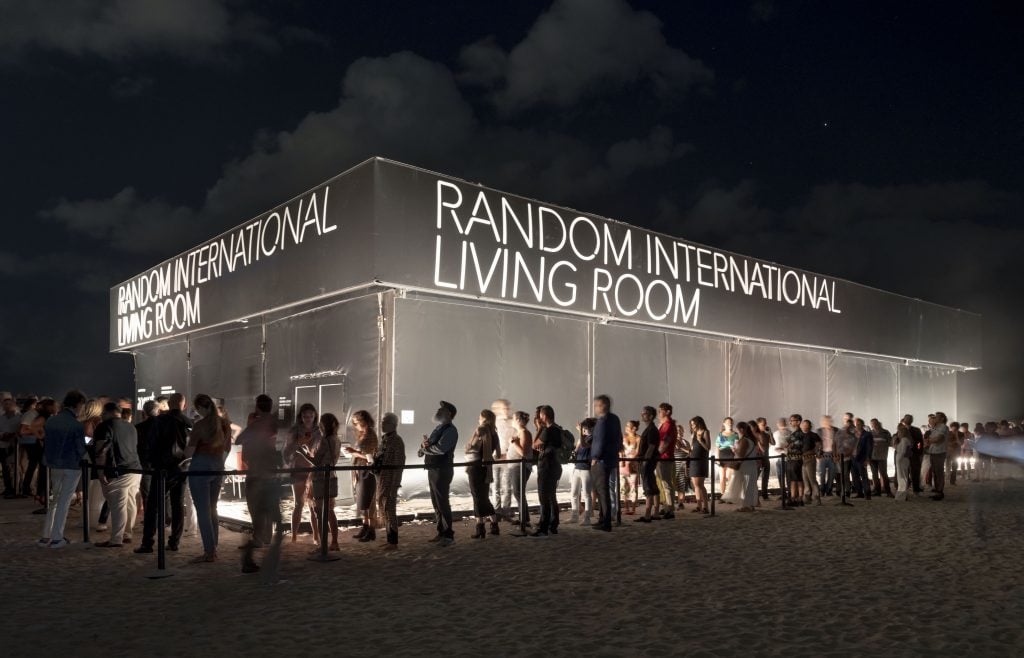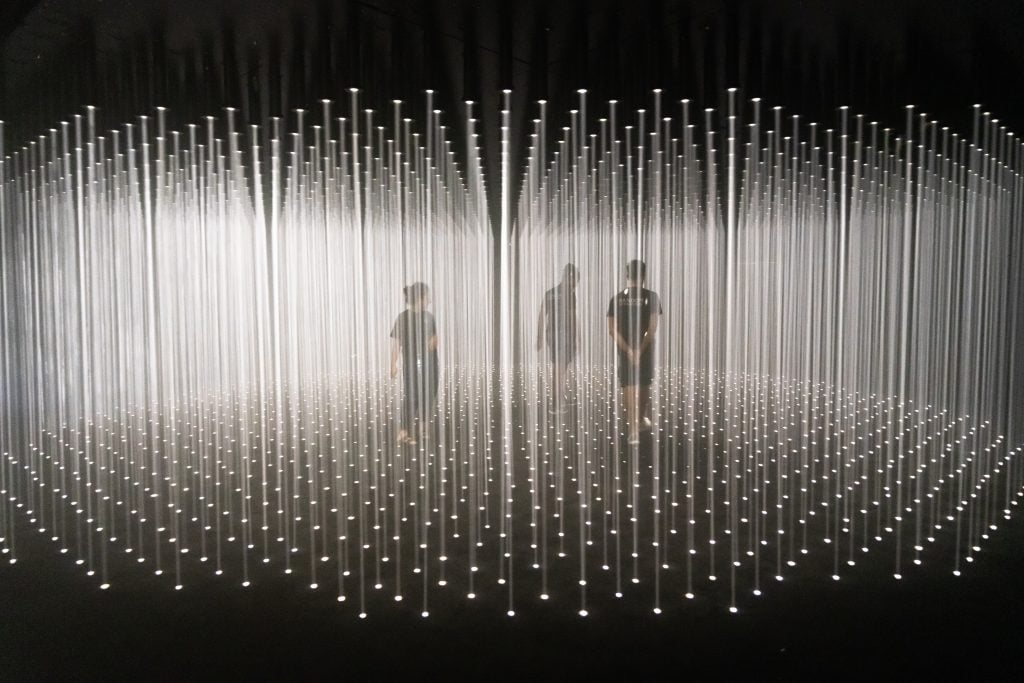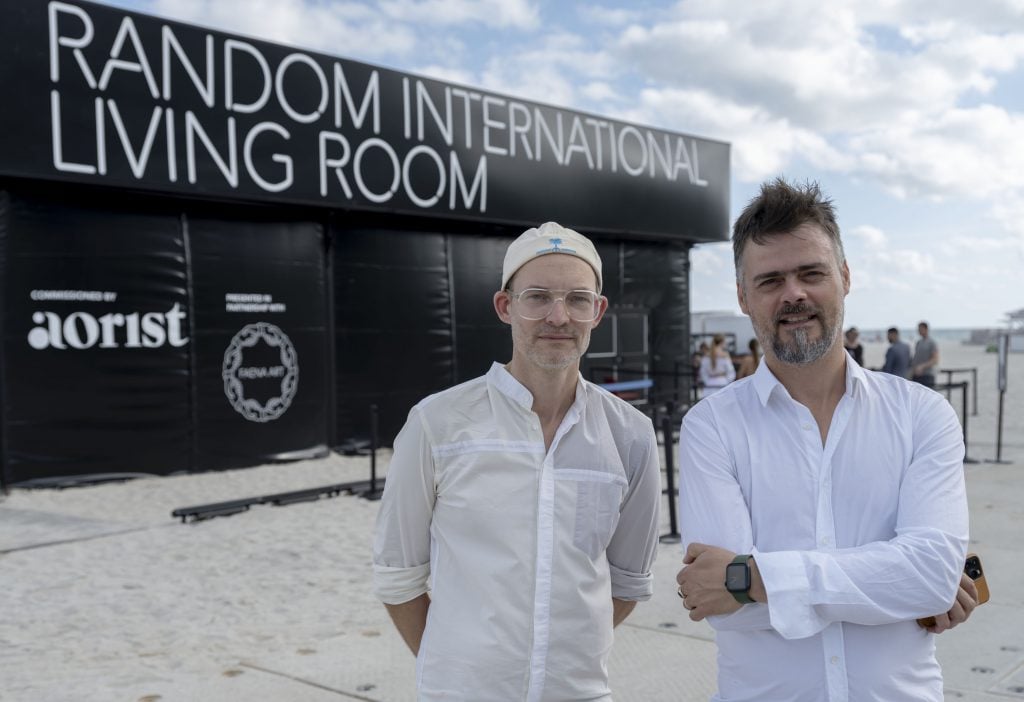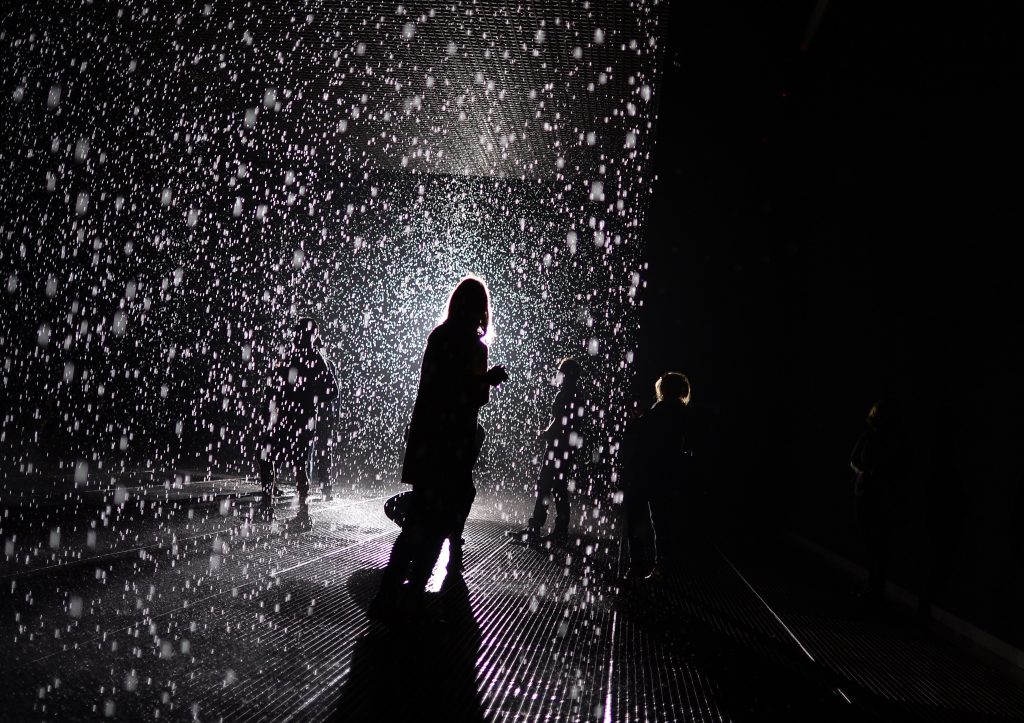The Gray Market
How Random International, Maker of the Immersive Sensation ‘Rain Room,’ Is Bringing the Experiential Art Business Into the 21st Century
The 'Living Room' appears 10 years after Random International's breakout 'Rain Room'.

The 'Living Room' appears 10 years after Random International's breakout 'Rain Room'.

Tim Schneider

Every Wednesday morning, Artnet News brings you The Gray Market. The column decodes important stories from the previous week—and offers unparalleled insight into the inner workings of the art industry in the process.
This week, a new hybrid in a field that’s grown old early…
When you burst onto the international cultural scene with an immersive installation so popular that it shifts the paradigm of ticketed art experiences, how do you ever go back to the genre? The question has been shadowing Random International since 2012, when its Rain Room, which allowed visitors to waltz through an artificial monsoon without getting wet, first enraptured audiences at the Barbican in London.
Ten years later, the collective has an answer. Its latest work, Living Room (2022), aims to complicate the crowd-pleasing default that has overtaken environmental installations generally, and to learn from the difficulties that emerged from touring Rain Room for tens of thousands of ticket buyers around the world. If it succeeds, Living Room could draw a new blueprint for success among artists producing immersive works, in no small part by rethinking how digital outputs could augment physical experiences.
Commissioned by Aorist, a self-proclaimed “cultural institution supporting a climate-forward NFT marketplace,” and presented in partnership with international nonprofit Faena Art, Living Room showed promising early returns. I was one of the roughly 8,000 people who went through the installation during its six-day run in Miami Beach during fair week. But there is a lot riding on whether or not that reception was a consequence of favorable scheduling or ongoing appeal.
What is Living Room, exactly?
“I would describe it as a physical encounter with a spatial entity: architecture that somehow pretends to be sentient,” Random International cofounder Hannes Koch told Artnet News. The installation’s main sensory element is an array of hundreds of narrow columns of light, which take on the illusion of physicality by interacting with an otherwise-invisible veneer of fog wafting through 100 square meters of darkened interior space. (Adding dimension to the experience is a score by acclaimed contemporary composer Max Richter.)
It’s what those columns of light do that backs up Koch’s pitch. “Rain Room was always a very passive thing,” he said. It only surrounded guests with a halo of dry space as they paraded through the downpour. “We wondered what it would be like if the space had some form of an attitude.”
Living Room fulfills that thought exercise by varying its reactions to its inhabitants. While visitors navigate the installation, a network of advanced sensors tracks their movements and cues the lighting system to respond with what Koch calls different “behaviors.” The pitch-black space might suddenly blare to life as the entire collection of lights powers on at once. The installation might cut out every light in a straight-line path between each person inside it, linking them together through a kinetic web of darkness. It can also invert this dynamic, enclosing every visitor in a narrow cage of light that stays locked around them no matter where (or how fast) they move.

Visitors inside Random International’s Living Room, Variation 1 (2022). Photo by Esteban Schunemann. Courtesy of Random International and Aorist.
The results manage to stimulate feelings that range from disorientation to wonder to unease. Living Room even tiptoes into technological and social critique. There’s more than a little irony in watching attendees get snapped into illuminated, mobile prisons and respond by staring into their smartphones to try to post the situation on their socials.
Thematically, Living Room continues the inquiry behind No One Is an Island, a public performance by Random International and choreographer Studio Wayne McGregor in 2021. That work addressed how we humans are learning to cohabitate with the growing ecosystem of technological presences we are building up around ourselves. In the performance, the artists explored the concept through the interplay of programmed robotic arms and professional dancers. In Living Room, Koch and Random International cofounder Florian Ortkrass wanted to focus on our relationship to algorithms, those immaterial presences that influence more and more of our daily lives.
In Koch’s telling, Living Room is about humanity’s innate desire to assign emotion, intention, and consciousness to anything that can even hint at those qualities. Whether or not a technology is actually sentient is irrelevant, because most people are inclined to believe it is anyway. Just think about how often people apply feminine pronouns when talking about Siri or Alexa, voice-activated algorithms developed by two of the world’s wealthiest corporations.
“I think we’re really not made for this neurologically or evolutionarily,” Koch said. “We want to be taken for a ride. It makes us happy and fulfilled. This incredible satisfaction mixed with incredible vulnerability means we’re opening ourselves up to all kinds of abuse and weirdness.”
The weirdness is only amplified by the fact that the algorithms subsuming an increasing share of our reality offer so few physical signs of their impact. The same is broadly true of Living Room. But aside from its multiple behaviors and disquieting themes, another way that the new installation steps forward from Rain Room is by empowering visitors to create permanent digital mementos on the blockchain.

Random International cofounders Florian Ortkrass (L) and Hannes Koch (R) outside Living Room (2022) during Miami Art Week 2022. Photo: Oriol Tarridas. Courtesy of Random International and Aorist.
Koch said that Aorist’s commission of Living Room came with only one condition: the work had to have some kind of on-chain expression. He and Ortkrass knew that they didn’t want to just create a static image or video clip of the physical installation that could be minted as an NFT. After some experimentation, they converged on a more ambitious and more collaborative option: converting visitors’ movements inside the installation into data visualizations unique to their experience.
Whenever a guest enters or exits Living Room, an attendant scans a Q.R. code on their ticket. The scans act as timestamps bracketing that person’s unique journey inside. While the installation’s sensors calibrate the various lighting behaviors, they also record each person’s motions through the space. Their positions, speed, and timing are then compressed and translated into kinetic digital line drawings, which can be minted as NFTs on Aorist’s platform. Think of it as a group portrait of an organic network changing over time, sped up and put on a continuous loop through the eyes of a computer.
“Internally, our dialogue was very strongly based in medical terms. Being inside the installation was being Inside the brain, dissecting it, and the [NFT] output is the MRI,” Koch said.
Comparing Living Room’s NFTs to brain imagery is especially apt when it comes to how Random International views the medium. Although the brain is a single organ, it is also a complex system that only works when its many biological components cooperate. To Koch and Ortkrass, the most exciting aspect of NFTs is their ability to connect everyday fans with artists so they can make something together. It isn’t just that Living Room gives visitors the opportunity to influence how the physical installation behaves during their time in the space; it’s also that their contributions will be recorded, processed, and used to output a complementary (digital) artwork in its own right.
That relationship was never possible before—at least not in the context of a universally recognized form of publishing. To Koch, NFTs are a way to update the prints and multiples model for the online-sharing culture of the 21st century.

An NFT minted from Random International’s Living Room V1 Community Variation (Miami) (2022). Courtesy of Random International and Aorist.
“For work like ours, and for other artists whose work is code and cameras and displays, this is the appropriate format to add to the canon of lithographs and editioned prints,” he said. “NFTs as a material allow you to be in direct touch with your audience and to co-create.”
As much as NFTs represent a step forward in art’s public accessibility, Koch still believes the barriers to entry have to be lowered even further. Case in point: as of this column’s deadline, only about 58 visitors had minted Living Room NFTs, according to a spokesperson, though they said numbers are expected to increase “significantly” over the coming weeks.
Part of the solution concerns the tech itself. Koch sees Aorist’s relative ease of use—Living Room visitors can mint their NFTs without having their own crypto wallet, for instance—as an advance toward the type of intuitive infrastructure needed for lay users to effortlessly buy, trade, and hold on-chain works from almost anywhere. “I don’t think it takes much imagination to see being able to do that in every museum shop,” he said.
The other variable in the equation is price. Simply put, Random International still wants NFTs to be significantly cheaper than most are. “We’d like it to be closer to 25 quid than 200,” Koch said. While at first that might seem like a curious position for a for-profit art collective to take, it dovetails with the studio’s larger goals for Living Room and its practice as a whole.
Random International is exploring the prospect of producing multiple variations of Living Room, each with one or more unique properties. For example, variations of the work may record the same visitor data but convert it into different on-chain visualizations. Koch said that these different iterations of the installation will “probably” be produced “in parallel.” Every one would be acquirable as an installation whose owner could then recoup the purchase price by selling tickets, just as a few institutions and private collectors did for editions of Rain Room (although, apart from their dimensions, those editions were essentially identical to one another).
While specific plans are still being finalized, Random International and Aorist also plan to tour Living Room somewhat like the collective toured Rain Room before it. Yet the challenge isn’t just how to streamline the physical production and transport the new installation. It’s also how to properly position Living Room in an experiential marketplace that has grown dramatically in size but not necessarily in substance over the past 10 years.

A visitor at Random International’s “Rain Room” at MOMA (2012). Photo: TIMOTHY CLARY/AFP via Getty Images.
To some extent, Random International is trying to thread the same needle as any other artist self-consciously pursuing a larger audience: How do you scale up without dumbing down to the lowest common denominator? The caveat is that the immersive experience economy has arguably rewarded racing to the bottom more than any other submarket in art and culture. Hollywood blockbusters, pop mega-hits, New York Times bestsellers—these and other categories all contain at least some commercial success stories that were also widely acclaimed by critics. With the possible exception of teamLab (whose interactive digital environments still mostly trigger shrugs among art-world tastemakers), I can’t in good faith say the same about for-profit immersive art experiences.
Koch recognizes that Living Room has a narrow path to reaching a wide audience without being dismissed as pure spectacle. Still, he feels like he and Ortkrass are approaching it from the best angle available.
“The expectation is that, to bring these experiences to a wide public, sometimes you need to make concessions. But that’s why we’re quite happily staying in the generally protected zoo that the art world is,” he said. An artwork like Living Room doesn’t have to deliver a guaranteed dopamine hit the way a pop-culture sensation does; it only has to promise to be a memorable experience.
That said, creating memorable experiences is not necessarily a business model on its own. “I think there’s a way to do this meaningfully and so that it profitably funds the next exploration,” Koch said. “It’s hard to build an economy around it, but we’re getting closer to figuring it out.”
It remains to be seen whether Random International will crack the case with Living Room. But through collaborative NFTs and quasi-franchising, the collective and its partners are thinking expansively about the business while trying to protect creative experimentation. If they succeed, the strategy certainly won’t take every immersive projection-fest built atop a great artist’s grave and transform it into something magical. But for high-quality experiential artworks that might otherwise drown in the ticketed flood, Living Room might at least illuminate an escape hatch.
That’s all for this week. ‘Til next time, remember: You miss 100 percent of the shots you don’t take.